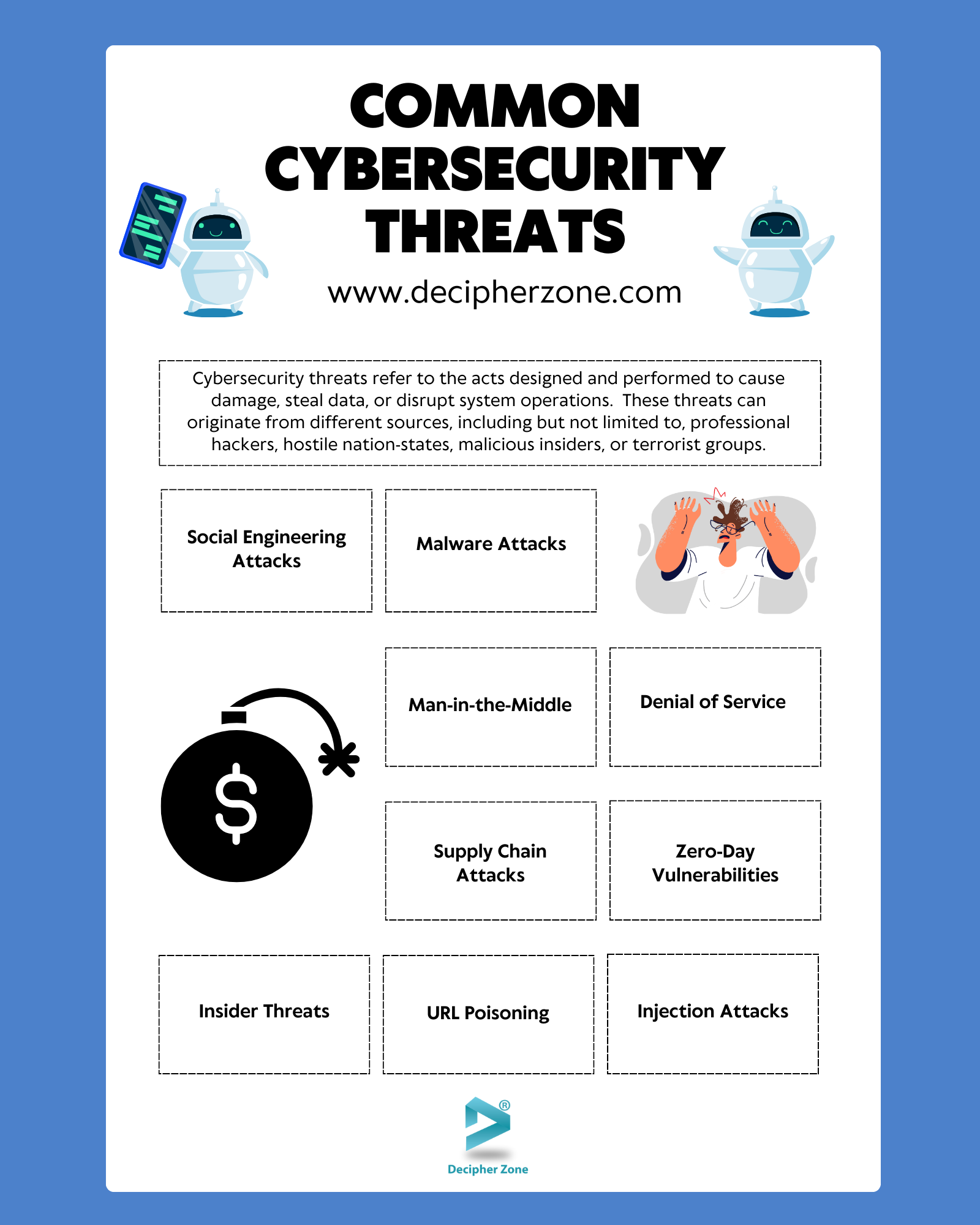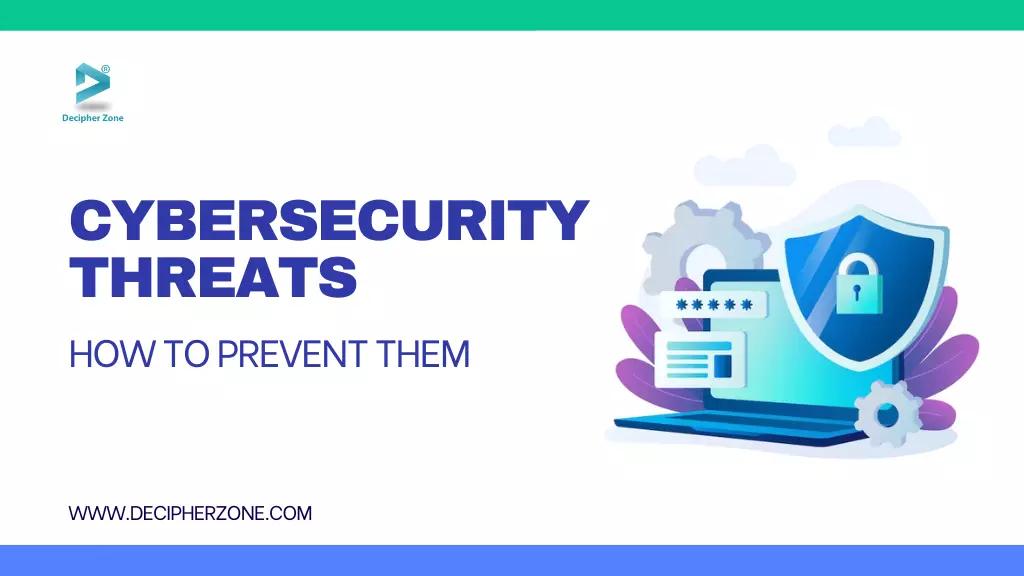What are the Common Cybersecurity Threats and How to Prevent Them? The continuous advancement in the information technology industry has expanded the opportunities and possibilities for businesses and individuals.
However, it has also increased the risk of cybersecurity threats. Cybercriminals are tremendously targeting organizations to steal sensitive information, leading to immense financial losses in businesses.
In today’s fast-paced digital world, cybercriminals are not part-time amateurs anymore. Instead, they have become professional criminals looking for ways to steal data for their advantage. Many companies struggle to keep their systems and applications protected from cyber threats.
In this blog, we will enlist the common cybersecurity threats you should be aware of and how to prevent them from happening in the first place.
Defining Cybersecurity and Cyber Security Threats
Cybersecurity is the process of protecting systems, devices, software, data, and networks from unauthorized access. Having strong cybersecurity practices in place can help individuals and organizations protect themselves against malicious cyber attacks done to access, delete, alter, and force their sensitive information and systems.
Contrastingly, cybersecurity threats refer to the acts designed and performed to cause damage, steal data, or disrupt system operations. These threats can originate from different sources, including but not limited to, professional hackers, hostile nation-states, malicious insiders, or terrorist groups.
List of 9 Common Cybersecurity Threats
Some of the 9 common cybersecurity threats that businesses have to deal with are as follows:
-
Social Engineering Attacks
-
Malware
-
Man-in-the-Middle
-
Denial of Service (DoS)
-
Supply Chain Attacks
-
Zero-Day Vulnerabilities
-
Insider Threats
-
URL Poisoning
-
Injection Attacks
1. Social Engineering Attacks
It is the term used to describe a broad range of malicious activities achieved through interacting with a person and tricking them into providing an entry point for attacks.
Here the attackers use psychological manipulation so that the person either gives away sensitive information or makes security mistakes. Some of the common forms of social engineering attacks are pretexting, baiting, phishing, vishing (voice phishing), smishing (SMS phishing), tailgating, and piggybacking.
2. Malware
It refers to the program designed to be installed on a device without the user’s consent to disrupt the server or network, leak private information, gain unauthorized access, manipulate and block access, or destroy data.
A few malware attacks that one could become a target of include worms, viruses, trojans, Emotet, crypto-jacking, ransomware, adware, spyware, rootkits, and file-less malware.
3. Man-in-the-Middle
An MITM attack is one where attackers either relay or alter communication between user and application, stealing sensitive data, eavesdropping on communication, or impersonating any party participating in it.
IP spoofing, Wi-Fi eavesdropping, email hijacking, DNS spoofing, HTTPS spoofing, session hijacking, SSL striping, and ARP cache poisoning are some examples of man-in-the-middle.
4. Denial of Service (DoS)
It is an attack that is designed to shut down the network or machine, making it inaccessible to the user either indefinitely or temporarily. It overloads the target system with massive traffic volumes that hinder the system’s ability to function as expected.
If this is done to multiple devices simultaneously then it is called distributed denial of Service (DDoS). Some of the common DoS attacks are SYN flood, UDP flood, NTP amplification, ICMP flood, HTTP flood, smurf attack, and Layer 7 DDoS attack.

5. Supply Chain Attacks
A supply chain attack targets a system through its network of organizations, individuals, resources, and activities involved in the creation and distribution of a product or service. Attackers exploit weaknesses in the interconnected and interdependent nature of the supply chain to compromise the ultimate target.
Some common examples of supply chain attacks include browser-based attacks, open-source attacks, JavaScript attacks, software attacks, watering hole attacks, cryptojacking, and magecart attacks.
Read More: Software Solutions for Manufacturing Industry
6. Zero-Day Vulnerabilities
It refers to the vulnerability in a system that is still unknown to the developer, owner, or anyone capable of mitigating it. Threat actors take advantage of these unknown/unaddressed security flaws to damage its processes or steal sensitive information. Trojans, viruses, polymorphic worms, etc. are some of the major causes behind zero-day vulnerability attacks.
7. Insider Threats
This risk arises when individuals within an organization exploit their access privileges to compromise the confidentiality, availability, and integrity of sensitive information, whether intentionally or unintentionally. Insider threats can happen because of malicious insiders, compromised insiders, or negligent insiders.
8. URL Poisoning
A URL is a unique identifier used to locate a resource on the internet. Hackers can modify URLs to access unauthorized information or resources. This type of attack is called insecure direct object reference and can result in the theft of confidential data or access to admin pages.
9. Injection Attacks
These exploit different vulnerabilities in the application to insert malicious content, leading to sensitive information exposure, system compromisation, and DoS attack execution. Some main vectors of injection attacks are code injection, SQL injection, LDAP injection, OS command injection, cross-site scripting, and XML eXternal Entities injection.
Read More: Types of Programming Paradigms
Ways to Prevent Cybersecurity Threats
A few ways in which one can prevent themselves from being a victim of cyberattack include:
-
Turn-On Multi-Factor Authentication
-
Think Before Clicking
-
Use Strong and Unique Passwords
-
Update Software Regularly
-
Update Software Regularly
-
Implement Unified Security Architecture
-
Install Firewalls
-
Backup Data
Turn-On Multi-Factor Authentication: It is always advisable to enable MFA wherever possible to add an extra layer of protection against cyber threats. MFA requires users to provide more than one method to verify their access authentication, making the application more secure.
Read More: Top 8 Cloud Security Risks and Tips to Overcome
Think Before Clicking: If you are getting suspicious emails or SMS with links or downloading attachments from unknown sources, think before clicking on them. To remain protected it is crucial to be aware of phishing tricks like these that trick users into sharing sensitive data.
Use Strong and Unique Passwords: Another useful but easiest method to protect yourself from cybersecurity threats is creating strong passwords. So, ensure you have different and strong passwords for different platforms. It is always a good idea to use a blend of numbers, special characters, lowercase, and uppercase letters in the password.
Update Software Regularly: Ensure to update the software and applications installed on your devices regularly as developers are bound to release security patches to fix bugs and vulnerabilities to enhance the system’s security.
Read More: What is Application Software - Examples & Types
Implement Unified Security Architecture: To add a layered defense against cybersecurity threats, deploy a comprehensive yet unified security architecture that comprises anti-malware tools, antivirus software, intrusion detection, and prevention systems.
Install Firewalls: Firewalls can act as a protective barrier between a trusted internal network and untrusted external networks, thereby preventing unauthorized access and data breaches. To further safeguard your data, it's recommended that you regularly back up important information to an external and secure location. This way, in the event of a cyberattack, your data can be easily restored, significantly reducing the impact of data loss or ransomware attacks.
Backup Data: It is highly recommended to regularly save important data to a secure external location. This practice can prove to be immensely helpful in case of a cyberattack as having backups ensures that data can be restored, thus reducing the impact of any potential data loss or ransomware attacks.
Conclusion
It is quite impossible to stay unaffected by these cybersecurity threats in the virtual world we are residing in. However, it is our responsibility to be aware of different types of cyber threats in the industry and the ways to mitigate them. We hope this blog has helped you understand these threats and how to prevent your business from getting attacked by cybercriminals.
If you are someone who wants to develop a secure and reliable web app or software to empower your business ROI, then contact our experts, share your requirements, and get a customized detailed quote now!
FAQs: Common Cybersecurity Threats and How to Prevent Them
What are Cybersecurity Threats?
Cybersecurity threats refer to the acts designed and performed to cause damage, steal data, or disrupt system operations.
What are the common cybersecurity threats?
Social engineering attacks, malware attacks, man-in-the-middle, denial of service, supply chain attacks, zero-day vulnerabilities, insider threats, URL poisoning, and injection attacks are some of the common cybersecurity threats in the industry.
How can one protect themselves from cyber-attacks?
To prevent being a cyberattack victim one can turn on multi-factor authentication, think before clicking, use strong and unique passwords, update software regularly, implement unified security architecture, install firewalls, and backup data.

